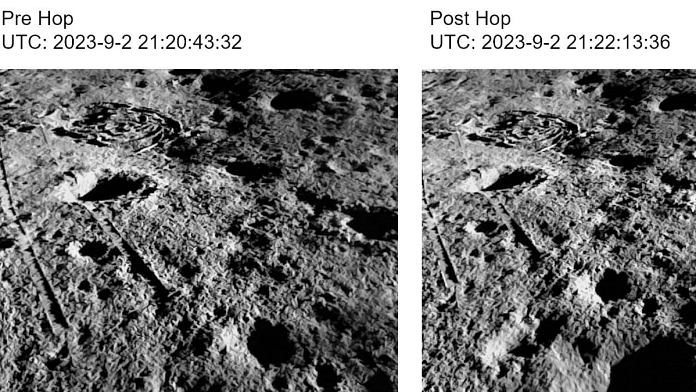Bengaluru: The Indian Space Research Organisation (ISRO) Monday announced that its Vikram lander — which landed on the moon as part of its Chandrayaan-3 mission — has successfully performed a ‘hop’ experiment, meaning it flew from its landing location to a spot just 40 centimetres away.
It did so by firing the lander’s engines and rising up by about 40 cm, then moving sideways by about the same distance, and finally landing at a new spot. This was done to demonstrate the technology of relaunching and precision landing on the moon, which is essential for future missions that aim to collect and return lunar samples to Earth.
Before the hop, the lander retracted its two deployed instruments — ChaSTE (Chandra’s Surface Thermophysical Experiment) and ILSA (Instrument for Lunar Seismic Activity) — along with the rover deployer ramp. After landing again, the ramp and the payloads were redeployed, and all systems performed as expected.
This makes Vikram the second lander to perform such a hop experiment after National Aeronautics and Space Administration’s (NASA) Surveyor 6 in 1967.
The Vikram lander performed this unannounced experiment shortly before it was put in low power mode for the lunar night at 8 am Monday IST. ISRO will attempt to revive the lander (and rover) on 22 September after the 14-day-long lunar night.
Since the lander and rover function on solar power, they might not survive the 14-day long lunar night in freezing temperatures, but ISRO scientists have said that they hope both the Vikram lander and Pragyan rover are capable of waking up again on the 22 September.
Also Read: Curious about what Chandrayaan-3 aims to do? All about its payloads & how they’ll help scientists
Significance of the test
The successful firing of engines was performed to demonstrate the technology of lifting off from the moon. Lateral movement and landing back showed the ability of a lander to hover after rising up and be able to touchdown safely again.
This experiment was done to assess and aid future missions built for sample returns to Earth. The first sample returns were performed by NASA’s crewed Apollo missions in the 1960s.
In the historic Apollo 11 mission in 1969, Neil Armstrong and Buzz Aldrin picked up the first pieces of lunar rock, and the first ever pieces of another body in the solar system, to take back to Earth. Both men carried around 22 kg of lunar material.
The five other crewed Apollo missions also carried lunar rocks and regolith (soil) weighing 382 kg, dug up by humans walking on the moon.
In the 1970s, the Soviet Luna programme also returned a total of over 300 kg of lunar material. Unlike the Apollo missions, these were fully automated and robotic.
After 40 years, lunar missions picked up again in the early 2000s, when China’s Chang’e 5 lander brought 2 kg of lunar samples to Earth in 2020.
Future planned missions for lunar sample returns are China’s Chang’e 6, which will launch next year, and Russia’s Luna 28, which is expected to launch in 2030.
The Chandrayaan programme will have its first lunar sample return as a part of Chandrayaan-6 — which will launch between 2030 and 2035.
Also Read: Chandrayaan-3 landing done. It’s now over to Pragyan Rover for next phase of Moon mission
Powered flights outside earth
The hop experiment by Vikram is not the only example of powered and controlled flight on another celestial body apart from Earth in the solar system. Several other missions have achieved this feat using different technologies and methods.
The very first such powered and controlled flight on Mars was performed by the Ingenuity helicopter of the Mars 2020 mission from NASA in 2021.
In 2020, NASA’s OSIRIS-REx mission, which was launched in 2016, picked up samples from the asteroid 101955 Bennu. It is expected to reach Earth this month with its contents.
In 2010, Japan’s Hayabusa returned asteroid samples to Earth after landing and then taking off from the asteroid 25143 Itokawa. Later, in 2014, the Hayabusa 2 mission landed on the asteroid 162173 Ryugu and lifted off the rock with samples for Earth in 2019.
Chandrayaan programme
ISRO’s Chandrayaan programme is planned in three phases. The first deals with the engineering of successful orbiters and impactors, which was demonstrated by the 2008 Chandrayaan-1.
The second stage deals with the engineering of landers and rovers. After 2019’s crash of the Chandrayaan-2 — the latest Chandrayaan-3 managed to land and rove with nearly identical payloads.
The third phase of the programme will be sampling material on site and returning collected lunar samples. The next mission, Chandrayaan-4 or Lunar Polar Exploration Mission (LUPEX) will perform landing, roving, and sample return, in collaboration with Japan. It is expected to launch in or after 2026.
(Edited by Richa Mishra)
Also Read: As Chandrayaan-3 touches down on Moon’s surface, meet the key scientists behind mission



